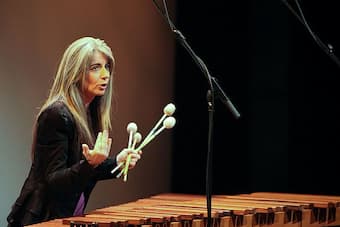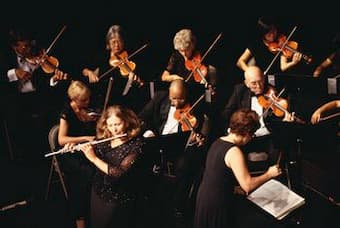
© work.chron.com
Many orchestra musicians start professional careers soon after graduating from a conservatory music performance program. There is a good chance that aspiring orchestra musician already gained first experience in ensembles, school orchestras, or by temping in a civic ensemble. After graduating, many musicians start working in community and regional orchestras, “honing their craft before auditioning for more prestigious orchestras in larger cities, where paychecks and the average level of playing are much higher.” Renowned orchestras are basically looking for “elite musicians with a high level of discipline and dedication… Orchestra members need patience, tenacity, confidence, and the ability to perform at a high level under immense pressure.” Having a collaborative, accommodating and friendly disposition is an essential character trait, as orchestra musicians need to be team players. Once an orchestra has employed a musician, they can advance within their instrumental section, eventually becoming principal players or section leaders, or in the case of the first violins, concertmasters. Be warned, however, section leaders tend to stay in their post for decades. In addition to rehearsing, performing, and recording, orchestra musicians can also diversify into becoming conductors or music directors, or pursue a career as a soloist. In this blog we continue with our exploration of famous orchestra musicians with one of the hottest tickets on the orchestra and concert stage today, the clarinetist Andreas Ottensamer.
Clarinettist: Andreas Ottensamer
Mozart: Clarinet Concerto “Adagio” (Andreas Ottensamer)
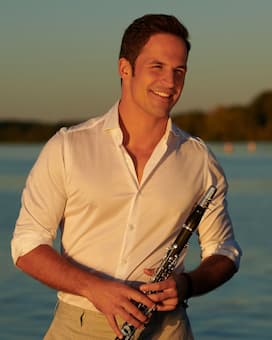
Andreas Ottensamer
Andreas Ottensamer was born into a distinguished family of Austro-Hungarian musicians in Vienna. His father Ernst was principal clarinet of the Vienna Staatsoper and the Vienna Philharmonic Orchestra, and his older brother Daniel is now co-principal clarinettist of the Vienna Philharmonic. Andreas began his musical studies at the University of Music and Performing Arts Vienna in 1999, first studying piano and then violoncello with Wolfgang Herzer. In 2003 he started clarinet lessons with Johann Hindler, a member of the Vienna Philharmonic Orchestra, and his interest in the cello faded quickly. Only two years later, Andreas formed an ensemble with his father and brother called “The Clarinotts.” Playing with his father and brother was a great challenge, and he recalls, “The improvements were so rapid that I quickly made up my mind to stick with the clarinet.” His talent and perseverance was quickly rewarded, and by the age of sixteen Andreas first appeared as a substitute with the Vienna State Opera and the Vienna Philharmonic. After finishing his schooling in Vienna, Ottensamer enrolled as an undergraduate at Harvard University, but interrupted his studies to become a fellow of the Orchestra Academy of the Berlin Philharmonic.
He launched his stellar orchestral career in 2010 as principal clarinet of the Deutsches-Sinfonie Orchester Berlin and was appointed in March 2011 to the same position with the Berliner Philharmoniker. In 2013 Andreas became the first clarinettist ever to sign an exclusive recording contract with Deutsche Grammophon, and he has since released a huge number of spellbinding recordings. Ottensamer has collaborated with musicians working in multiple genres, including Tori Amos, and he has cultivated chamber music partnerships with, among others, Yuja Wang, Leonidas Kavakos, Janine Jansen, Lisa Batiashvili, Nemanja Radulović, Sol Gabetta and Nicolas Altstaedt. A critic wrote, “his heartfelt performances penetrate the surface brilliance of virtuoso showpieces to reveal hidden depths of emotion, while his multi-layered meditations on the most lyrical of clarinet melodies span a vast landscape of feelings and expression.” His celebrated rich and warm tone flows with extraordinary empathy, complemented by a peerless technique and uncommon musical wisdom. Ottensamer is undoubtedly one of the most famous orchestra musicians today; “he simply is a phenomenon.”
Cellist: János Starker
Bach: Cello Suite No. 3 (János Starker)
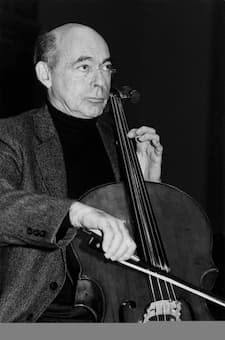
János Starker
Cellist János Starker was greatly admired for the silken richness of his tone and an expressive purpose governed by deep musical sensibility. “He was the dedicatee and first performer of concertos by Bernard Heiden (1967) and Miklós Rózsa (1968), and was active in chamber ensembles, including the Roth String Quartet (1950–53) and a piano trio with Josef Suk and Julius Katchen.” Starker was born in Budapest, Hungary, and he entered the Budapest Academy at the age of seven and made his solo debut four years later. Unbelievably, Starker started to teach other children at the age of eight, and by the time he was 12, he had five pupils. He made his professional debut at age 14, playing the Dvořák concerto with three hours notice when the originally scheduled soloist was unable to perform. After the war, Starker became principal cellist in the Budapest Opera and the Budapest Philharmonic Orchestra. He left Hungary in 1946, and after a successful concert in Vienna, and receiving a bronze medal at the Geneva Cello Competition, Starker spent a year working on his technique in Paris. He writes, “I played like a blind man. What happens to the bird who flies and doesn’t know how it flies? That’s what happens to child prodigies.” In 1948 Starker settled in the USA, where he became principal cellist of the Dallas SO (1948–9), the Metropolitan Opera Orchestra (1949–53), and the Chicago SO (1953–8). One of the most famous orchestra musicians of all time, Starker was appointed professor of cello at Indiana University, Bloomington in 1958, and he devoted himself to teaching the next generation of principal cellists for the rest of his life.
Flautist: Emmanuel Pahud
Fauré: Fantaisie, Op. 79 (Emmanuel Pahud)
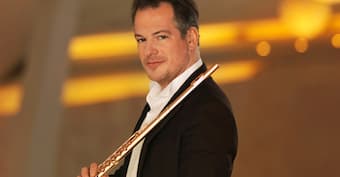
Emmanuel Pahud
Emmanuel Pahud is widely considered the finest flautist of his generation, “admired for the purity and subtlety of his tonal palate, his imaginative phrasing and his command of a broad range of style.” At the age of four, Pahud first heard the flute, as the son of a Swiss-French family living next door played Mozart’s Flute Concerto No. 1. Pahud recalls, “I could hear the flute, the violin, the cello, the piano. I don’t know why I chose the flute but maybe it was because the eldest son was playing it, so he was the one playing at the best level at that time—or because the father was also a flute player, so there was a kind of authority there. Anyhow, I said to my parents, I want to play the flute. I want to play the Mozart concerto that guy next door is practicing.” That Christmas he received his first flute, and Pahud began lessons with Philippe, the guy next door who was only 15 years old, and with Phillipe’s father, François. François had been a flautist who studied in Zurich and Paris, but stopped performing in later years.
When his family moved to Brussels, Pahud studied at the Music Academy of Uccle with Michel Moinil and subsequently with Carlos Runeel, the then current principal flautist of the Théâtre Royal de la Monnaie opera house in Brussels. In 1985, Pahud won the National Competition of Belgium and in the same year, he played his first concert with the National Orchestra of Belgium. Pahud continued his studies at the Conservatoire de Paris, taking lessons with Michel Debost, Alain Marion, Pierre Artaud, and Christian Larde. He won second Prize at the International Scheveningen Music Competition, which led to an appointment of principal flautist in the Basel Radio Symphony. Subsequently Pahud held the principal flautist position at the Munich Philharmonic under Sergiu Celibidache. After graduating with the Premier Prix, Pahud continued advanced studies for the next two years with Swiss-born Aurèle Nicolet. She prepared him for a number of competitions, and for his audition for principal flautist of the Berlin Philharmonic Orchestra. He was appointed at age 22, and has subsequently appeared as a recitalist and concerto soloist throughout the world. He is, without doubt, one of the most famous orchestra musicians today.
Trumpeter: Adolph Herseth
Mahler: Symphony No. 5 (Adolph Herseth)
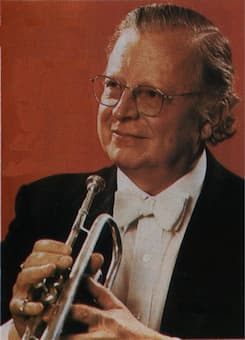
Adolph Herseth
The symphony orchestra is the ultimate instrument. The sheer range of musical colors and textures, huge dynamic contrasts ranging from delicate hums to the mightiest roars, and variations in tempo and articulation invariably communicate the deepest passions humanity is capable of. A distinctive symphonic sound is shaped by the skillful interaction of all orchestral members, and by the conductor directing musical traffic. In terms of orchestral sound, nothing beats the gleaming brass sound of the Chicago Symphony Orchestra. And that sound was in part shaped and established by Adolph Herseth, widely regarded as one of the greatest orchestral trumpeters of his generation.
He was the principal trumpet of the Chicago Symphony for 53 years, performing under Bruno Walter, George Szell, Eugene Ormandy, Leonard Bernstein, James Levine, Claudio Abbado, and many other prominent orchestral conductors. His tenure in the orchestra spanned the time of 6 different CSO music directors – Artur Rodziński (1947-1948), Rafael Kubelik (1950-1953), Fritz Reiner (1953-1962), Jean Martinon (1963-1968), Sir Georg Solti (1969-1991), and Daniel Barenboim (1991-2006). A critic wrote, “The CSO has long been recognized as one of the world’s great orchestras, and Adolph Herseth has had a major role in the evolution of its distinctive sound.” And the Chicago Sun-Times added, “For decades Herseth’s rich, golden tone and powerful yet expressive playing were a cornerstone of the fabled Chicago Sound.” Furthermore, Herseth made “Chicago an international center for the study of brass instrument performance.”
Guitar and Mandolin Player: JoAnn Falletta
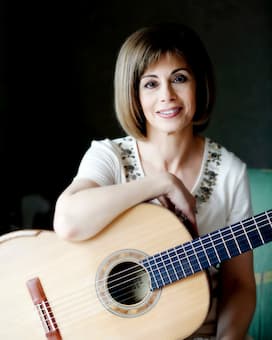
JoAnn Falletta
Multiple Grammy-winning conductor JoAnn Falletta, acclaimed as “one of the finest conductors of her generation,” was the first woman appointed Music Director of a major American Orchestra, the Buffalo Philharmonic Orchestra. Previously she had been the music director of the Jamaica Symphony Orchestra, the Denver Chamber Orchestra, associate conductor of the Milwaukee Symphony Orchestra, music director of the Bay Area Women’s Philharmonic and the Long Beach Symphony orchestra. She was also appointed the eleventh music director of the Virginia Symphony Orchestra. Gramophone Magazine named her one of the “50 great conductors of all time,” and she has compiled an impressive discography of over 120 titles. However, Falletta wasn’t born a conductor but began her musical career as a guitar and mandolin player. In fact, she studied guitar at Mannes College of Music, and was frequently called upon to perform with the Metropolitan Opera and the New York Philharmonic when a work called for a mandolin or guitar obbligato. Falletta had always been interested in orchestral conducting and pursued study at Queens College and the Juilliard School of Music with Jorge Mester, Sixten Ehrling, and Semyon Bychkov. She also participated in master classes with Leonard Bernstein, and the rest as they say, is history. Falletta still actively plays mandolin and guitar, and in 2004 the “JoAnn Falletta International Guitar Concerto Competition” was established in her honor. Orchestra musicians turned conductors don’t get any more famous than JoAnn Falletta.
Villa-Lobos: Bachianas Brasileiras No. 5 (JoAnn Falletta)
Violinist: Albena Danailova
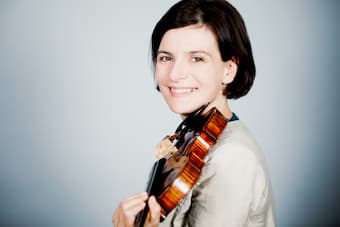
Albena Danailova
Albena Danailova is called the “First Lady” of the Vienna Philharmonic. Mind you, that’s not an honorary title as she is actually the first female concertmaster in the 180-year history of the orchestra. Born in Sofia, Bulgaria, she studied violin with Nelli Shelewa at the National Music School “Ljubomir Pipkov” and then with Prof. Dora Ivanova at the National Music Academy “Pantscho Wladigerow.” She remembers starting taking lessons “around the age of 4 or 5, and like most of my peers in Bulgaria, it wasn’t until I was 13 or 14 that I realized that making music gives me maximum freedom.” She continued her studies at the University of Music and Theater in Rostock with Prof. Petru Munteanu, and subsequently moved to Munich. “I think that for the people who deal with our art,” she explained, “Germany and Austria are the most attractive because that’s where you do most of the classical music. I already had experience as concertmaster of the Bavarian State Orchestra when I read in a trade journal that the same position was vacant with the Vienna Philharmonic. The first time they stopped the auditions and didn’t hire anyone, but the second time I knew inside I could do it. I can’t say why, but I really wanted the job and I was sure of it. I won the audition, and the whole orchestra congratulated me. Then I had two months to move to Vienna and start working. It has remained that way to this day—work and more work.”
Albena Danailova was only the sixth or seventh woman in the orchestra, and in her opinion, the slower entry of women into the legendary orchestra can be explained by the fact that the Viennese strictly adhere to traditions. “Basically, the orchestra’s approval of admitting women dates back to the 1990s…The Austrians themselves like to joke about it and say: When the world ends, come to us, because everything happens here 30 years later. I don’t know how many women are in the orchestra today; maybe close to 20; that would have been unthinkable ten years ago. Together with my colleagues we often play chamber music in different formations—from trio to octet or nonet. Almost everyone does that, because it keeps us fit as instrumentalists and is also part of our job.” Danailova is one of the most famous orchestra musicians, and she dreams of a world without restrictions and more music, “not just for us, professional musicians but most of all for the young and for children.”
For more of the best in classical music, sign up to our E-Newsletter
Shostakovich: Walz No. 3 (Albena Danailova)

